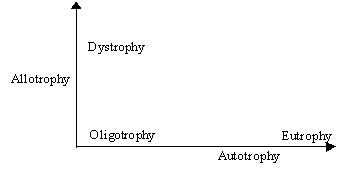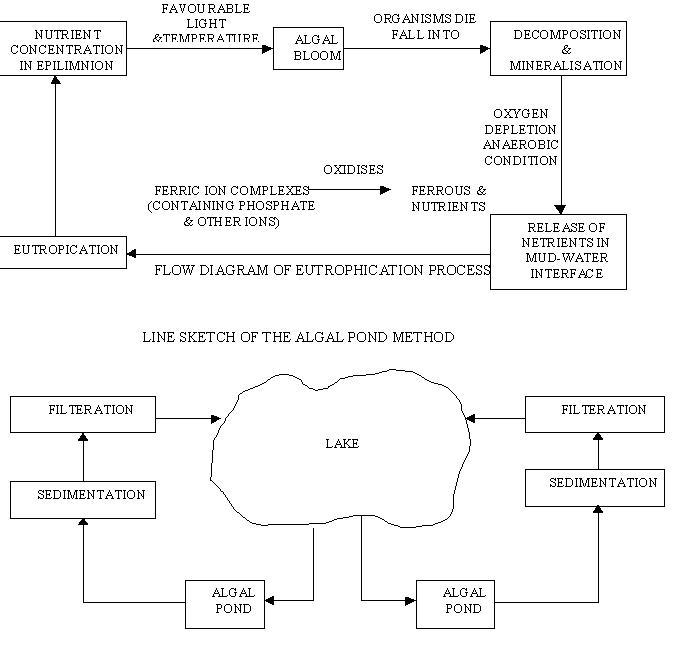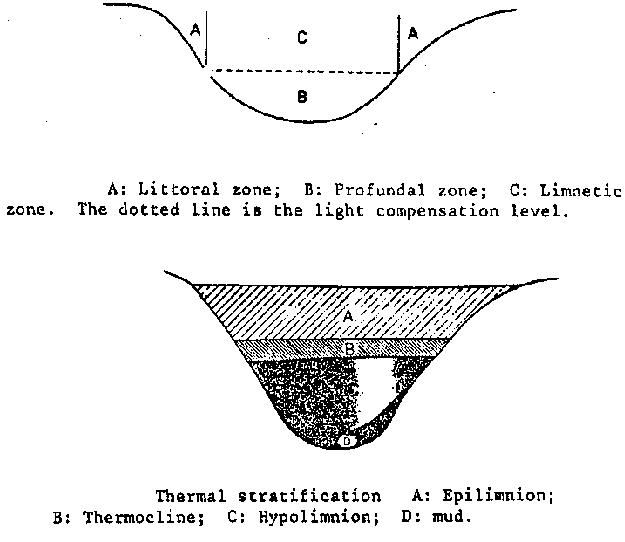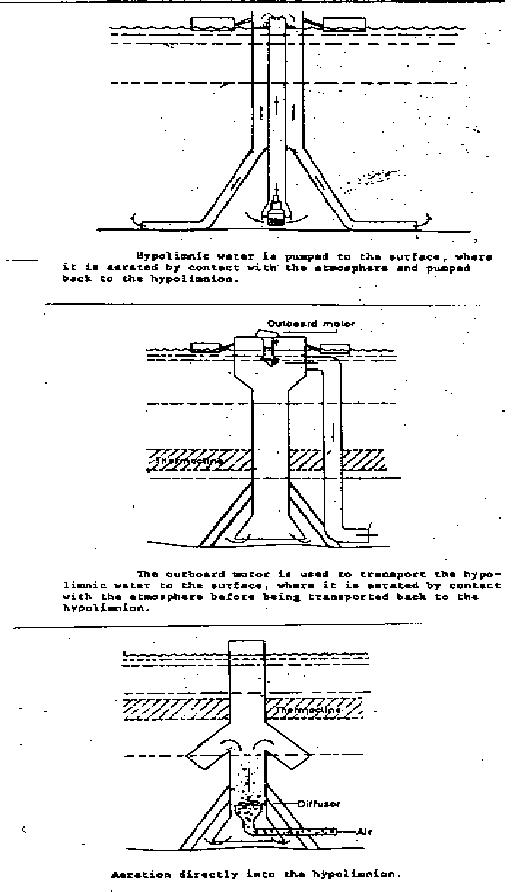
|

|

|

RECLAMATION OF LAKES
T. Meenambal , S. Prabha1 and S.S. Vidhya1


|

|

|


 ABSTRACT
ABSTRACT
 INTRODUCTION
INTRODUCTION
 STUDY OF LAKES
STUDY OF LAKES
 LIGHT STRATIFICATION
LIGHT STRATIFICATION
 THERMAL STRATIFICATION
THERMAL STRATIFICATION
 PRODUCTIVITY STRATIFICATION:-OLIGOTROPHIC SERIES
PRODUCTIVITY STRATIFICATION:-OLIGOTROPHIC SERIES
 EUTROPHIC SERIES
EUTROPHIC SERIES
 DYSTROPHY
DYSTROPHY
 SELF PURIFICATION PROCESS IN LAKES
SELF PURIFICATION PROCESS IN LAKES
 PRACTICAL CONSIDERATION IN RECLAMATION
PRACTICAL CONSIDERATION IN RECLAMATION
 RECLAMATION METHODS
RECLAMATION METHODS
 REDUCTION OF THE EXTERNAL LOADING
REDUCTION OF THE EXTERNAL LOADING
 INTERVENTION IN THE LAKE ECOSYSTEM
INTERVENTION IN THE LAKE ECOSYSTEM
 AERATION OF WATER
AERATION OF WATER
 DIVERSION OF HYPOLIMNIC WATER
DIVERSION OF HYPOLIMNIC WATER
 PRECIPITATION OF PHOSPHORUS IN THE LAKE
PRECIPITATION OF PHOSPHORUS IN THE LAKE
 REDUCTION OF BIOMASS CONCENTRATION
REDUCTION OF BIOMASS CONCENTRATION
 AERATION OF SEDIMENT
AERATION OF SEDIMENT
 REMOVAL OF SEDIMENT
REMOVAL OF SEDIMENT
 COVERING OF SEDIMENT
COVERING OF SEDIMENT
 ADMISSION OF UNPOLLUTED WATER
ADMISSION OF UNPOLLUTED WATER
 CASE STUDY
CASE STUDY
 USE OF RECLAIMED WATER:-DIRECT REUSE ABOVE GROUND
USE OF RECLAIMED WATER:-DIRECT REUSE ABOVE GROUND
 GROUND WATER RECHARGE
GROUND WATER RECHARGE
 CONCLUSION
CONCLUSION
 BIBLIOGRAPHY
BIBLIOGRAPHY
 FIGUES
FIGUES
| ABSTRACT: |




|
The main objective of this paper is to bring out a suitable method for restoring lakes. The amount of fresh water on the earth is very small compared to seawater. Continued population growth and contamination of both surface and ground water due to effluent discharge from industries, uneven distribution of water resources and periodic droughts have forced water agencies to search for innovative sources of water supply. There is an urgent need for reclaiming the lakes. Some general comments on restoration methods are made and it is suggested that by diverting the discharge water and treating part of the lake water and using it as dilution water, an effective reclamation is possible. The reclaimed water can be used for various purposes.
| INTRODUCTION: |




|
Inland waters cover less than 2% of the earth's surface and oceans (99%) cover 71% with an average depth of 3800m. Lake Baikal - the deepest lake in the world with a maximum depth of 1620m contains 20% of the earth's freshwater occupying a volume of 23,000 km2. The relatively small amount of water that occurs in freshwater lakes, have their basic importance in maintenance of terrestrial life. Freshwater supply is a serious problem in many parts of the world due to a number of factors as follows:
The impacts of overuse are changing and often distorting the ecological character of the lake. Commercial fish catching has declined due to pollution, over fishing, navigation and competition from the sports fishery. River that feeds the lake brings excess nutrients and toxins from industrial wastes and dredging activities. The pollution of lakes by toxic elements increases the depletion of available fresh water. The study of a lake and its importance is crucial when looking for restoration methods that will protect the lake from further pollution and reclaim it back to its natural state.
| STUDY OF LAKES: |




|
Stratification of lakes is done based on light, heat and productivity.
| LIGHT STRATIFICATION: |




|
Depending on the light penetrating the shallow lakes, they are classified as:
| THERMAL STRATIFICATION: |




|
Thermally lakes are divided into:
|
PRODUCTIVITY STRATIFICATION:
OLIGOTROPHIC SERIES: |




|
| EUTROPHIC SERIES: |




|
They are shallow lakes and littoral vegetation is abundant. Plankton concentration is more with low transparency.
Trophic level refers to the organic matter in the lake. Depending on the organic matter the lake has been classified as below.

| DYSTROPHY: |




|
Receiving large portion of the organic matter from external sources is called Dystrophy. Difference between dystrophy and eutrophy is the organic matter, allocthanous and autotropic respectively.
| SELF PURIFICATION PROCESS IN LAKES: |




|
There are different processes that take place in the lake such as photosynthesis, Carbon, Nitrogen, Phosphorus, Silica and Sulphur cycles, etc., that help in self purification. Rivers get polluted by waste water discharged in to them. As the lakes get water from rivers, streams, precipitation etc, they get polluted with organic and inorganic wastes. As a result, the natural self purification process gets overburdened and disturbed, due to which a large amount of toxic substance remains in the lakes.
| PRACTICAL CONSIDERATION IN RECLAMATION: |




|
Based on field experience, four conditions are necessary to justify construction of separate facilities for water reclamation.
| RECLAMATION METHODS: |




|
Restoration method is of two types:
| REDUCTION OF THE EXTERNAL LOADING: |




|
A reduction of the external loading can be carried out by totally stopping the in flow of wastewater or diverting the waste water into another ecosystem like sea where the retention time is low. Wastewater containing nutrients such as phosphorus, nitrogen, etc can be diluted in the sea. Before that, a comprehensive study has to be made. With advanced waste water technology available these days, water treatment methods meet all the criteria.
| INTERVENTION IN THE LAKE ECOSYSTEM: |




|
Methods under intervention of the lake ecosystem are:
| AERATION OF WATER: |




|
Oxygen depletion occurs in the hypolimnion due to decomposition of organic matter. Oxygen concentration in lake water is of direct importance for all living organisms in the lake.
Destratification might in some cases have a negative effect on water quality due to high temperature at hypolimnion. The other two methods seem to reduce the hydrogen sulphide and phosphorus concentration and increase the oxygen concentration, while the direct effect on primary production is minimal.
| DIVERSION OF HYPOLIMNIC WATER: |




|
Hypolimnic water is rich in nutrients and poor in oxygen. By diversion of hypolimnic layer with that of epilimnic water, nutrient and oxygen balance improves. But due to heat exchange there is some disadvantage.
| PRECIPITATION OF PHOSPHORUS IN THE LAKE: |




|
Phosphate can be precipitated by using aluminium sulphate, iron chloride or calcium hydroxide. Phosphate concentration is reduced after the addition of the precipitant but the effect is short lived. No further reduction in the primary production is observed concluding that chemical precipitation alone is inadequate. It is worth considering when used with other restoration methods.
| REDUCTION OF BIOMASS CONCENTRATION: |




|
In hyper-eutrophic lakes the production of biomass is many times faster than their consumption by grazing animals. By introducing herbivorous animals, it is possible to increase the grazing rate. For this method it is necessary that the oxygen concentration and pH - is good enough to allow the breeding of the introduced animals. Experience with this method is limited and it must be concluded that at its present stage, it is difficult to control.
| AERATION OF SEDIMENT: |




|
Under aerobic conditions, the sediments are able to bind substantial amounts of phosphorus while under anaerobic conditions the sediments will release a significant part of phosphorus. The principles of sediment aeration are same as those described for aeration of hypolimnic water. The difference is whether aeration focuses on the oxygen concentration in the water or on the sediment surface.
| REMOVAL OF SEDIMENT: |




|
Experience with removal of sediment shows an essential decrease of phosphorus concentration, reduction in algal growth, disappearance of blue-green algae and increase in transparency. It is necessary to take the entire phosphorus input into consideration when a restoration solution is being selected. This method is ideal, provided the total phosphorus input is reduced significantly. Unfortunately this method is expensive and is generally not applicable.
| COVERING OF SEDIMENT: |




|
Covering of sediment will prevent the release of nutrients in to the water body. Application of plastic sheets, fly ash, iron rich sand or clay has been suggested. The method is much cheaper than removal of the sediment, but has the following disadvantages:
| ADMISSION OF UNPOLLUTED WATER: |




|
By addition of unpolluted water with low nutrient concentration to the lake, the lake water is diluted and the sediment is washed out. With decreased nutrient concentration, transparency increases and blue green algae disappears. This method must generally be considered attractive, but the admission of water might cause unacceptable changes in stratification due to difference in water temperature.
| CASE STUDY: |




|
As seen above no single method can be used effectively in reclamation of lakes. With the combination of precipitation and diversion of the waste water, a better reclamation method can be established. Considering the precipitation method, a pilot pond is constructed with shallow depth, to avoid bloom of zooplanktons, and stocked with fish. Presence of such zooplankton predators is necessary for achieving a stable ecosystem. Growth of phytoplankton makes nitrogen a growth limiting factor. Algae can be separated from the effluent by coagulation with alum followed by either sedimentation or filtration. Reduction of phosphorus and nitrogen concentration (by precipitation) could be brought to 39% and 30% respectively. Effective algal separation could be brought using alum when the concentration of phosphorus is reduced (91 to 93%). Water from the lake is diverted to the pilot pond for purification and then returned to the lake. The thermal stratification is not altered. This has been effected in Lake Washington where the lake has started getting back to its original state. After few years, the nutrient concentration in the lake will be highly reduced by the pilot pond. Any addition of polluted water with less nutrient will be purified by the lake's self-purification mechanism.

|
USE OF RECLAIMED WATER:
DIRECT REUSE ABOVE GROUND |




|
1. Industry
2. Aquaculture
3. Recreational activities
| GROUND WATER RECHARGE |




|
1. Surface spreading
2. Direct injection into aquifers
3. Over irrigation of crops
4. Sub surface percolation systems
| CONCLUSION: |




|
This restoration method has been carried out without altering the lake's own stratification so that the reclamation of lakes can be effectively achieved.
| BIBLIOGRAPHY: |




|
| FIGURES |




|


| ADDRESS |


|
1.) Department of Environmental Engineering,
Government College of Technology,
Coimbatore - 641 013

|

|